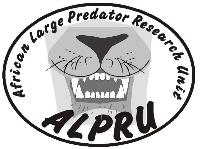ALPRU

The larger African predators are good indicators of the well-being of the natural environment, specifically the habitat and prey species. Thus, the focus of ALPRU is broader than the larger African predators and includes important aspects of the prey animal base and their habitat. Wild animal species are also maintained in captive environments, therefore the focus and activities of ALPRU include both in situ and ex situ populations.
Photographs taken by Willie Combrinck
The objectives of ALPRU are to:
- create a site and a research unit where relevant information regarding the large African predators can be collated, organised, and stored in a systematic way.
- serve as a centre of excellence from where relevant information regarding the large African predators can be disseminated.
- create an international network of individuals, specialist interest groups, institutions, non-governmental organisations (NGOs), and governments who are focusing on the respective large African predators.
- undertake research programmes related to large predator ecology within the boundaries of the Free State, South Africa, and on the African continent - on ALPRU"s own initiative or at the request of individuals or relevant organisations.
- promote association, cooperation, and collaboration with specialist interest groups that are focusing on the respective large African predators.
- remain holistic in its approach and be sensitive towards the African biodiversity.
The focus areas and activities of ALPRU are to:
- be comprehensive in its approach to conduct research and gather information on relevant aspects of the large African predators; specifically those in Southern Africa, but also the rest of the African continent.
- engage in cross-border programmes in research and other activities, as mandated or requested by different governments and/or universities and/or national/international conservation bodies, NGOs or individuals.
- recognise and focus on African biodiversity in terms of the indigenous fauna and flora within ecosystems, irrespective of the pristine or fragmented nature of such ecosystems.
- strive to secure continuity in the specific and relevant objective research and habitat management over the short, medium and long term.
- encourage the exchange of students at undergraduate and postgraduate level as part of a comprehensive research-based conservation strategy within both in situ and ex situ populations.
- collate, organise, store, and disseminate relevant information.
- maintain the highest level of scientific integrity.
- remain independent and impartial.
Contributors
Since its founding on 4 March 2002 at the University of the Free State, several individuals have been associated in different capacities with ALPRU, either as specialists or as students.
ALPRU is administrated under the direction/supervision of HO de Waal.
Specialists who have contributed to ALPRU:
Willie Combrinck
Nico Avenant
Daryl Barnes
Anne-Marie Pretorius
Luis Schwalbach
Sarel van der Merwe
Students who completed scientific studies under ALPRU:
Honours degrees
Elizma Theron (2003): Determining the defecation interval of a captive male leopard by means of different colour prey animal hair in its scat.
Joan Lessing (2003): A perspective on the caracal, the black-backed jackal and the Cape fox as problem animals.
Yanna Smith (2003): Aspects of faecal collection from captive African lions (Panthera leo Linnaeus, 1758) under Zoo and nature reserve conditions to determine the apparent digestibility of animal carcasses.
Master's degrees
Dirk Borstlap (2003): Intake and digestibility studies with captive African lions (Panthera leo), leopards (Panthera pardus) and cheetahs (Acinonyx jubatus).
Henriette Stander-Breedt (2004): Sperm cryopreservation, in vitro fertilization and faecal oestrogen enzyme immunoassay validation in the African lion (Panthera leo).
Yanna Smith (2004): Aspects of the behaviour of the African lion (Panthera leo) in an extreme environment.
Quinette Gunter (2008): A critical evaluation of historical data on two damage causing predators, Canis mesomelas and Caracal caracal.
Walter van Niekerk (2010): The cost of predation on small livestock in South Africa by medium-sized predators.
Coenraad Badenhorst (2014): The economic cost of large stock predation in the North West Province of South Africa.
Anche Schepers (2016): The economic impact of predation in the wildlife ranching industry in Limpopo, South Africa.
Doctoral degrees
Norman Monks (2009): The demography and population status of lions (Panthera leo) in the Mana Pools National Park, Zimbabwe.
Jurie du Plessis (2013): Towards the development of a sustainable management strategy for Canis mesomelas and Caracal caracal on rangeland.
Quinette Kruger (2019): Developing a management information system for coordinated predation management in South Africa.
For a list of publications conducted under the auspices of / in collaboration with ALPRU, see ALPRU studies.